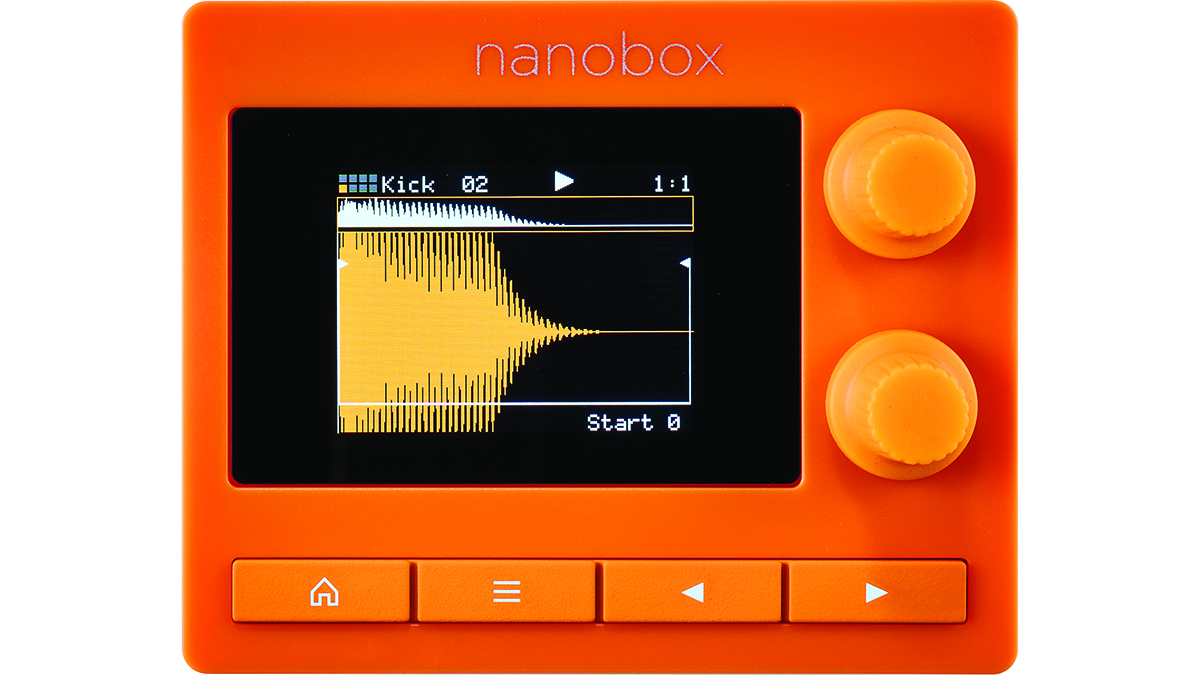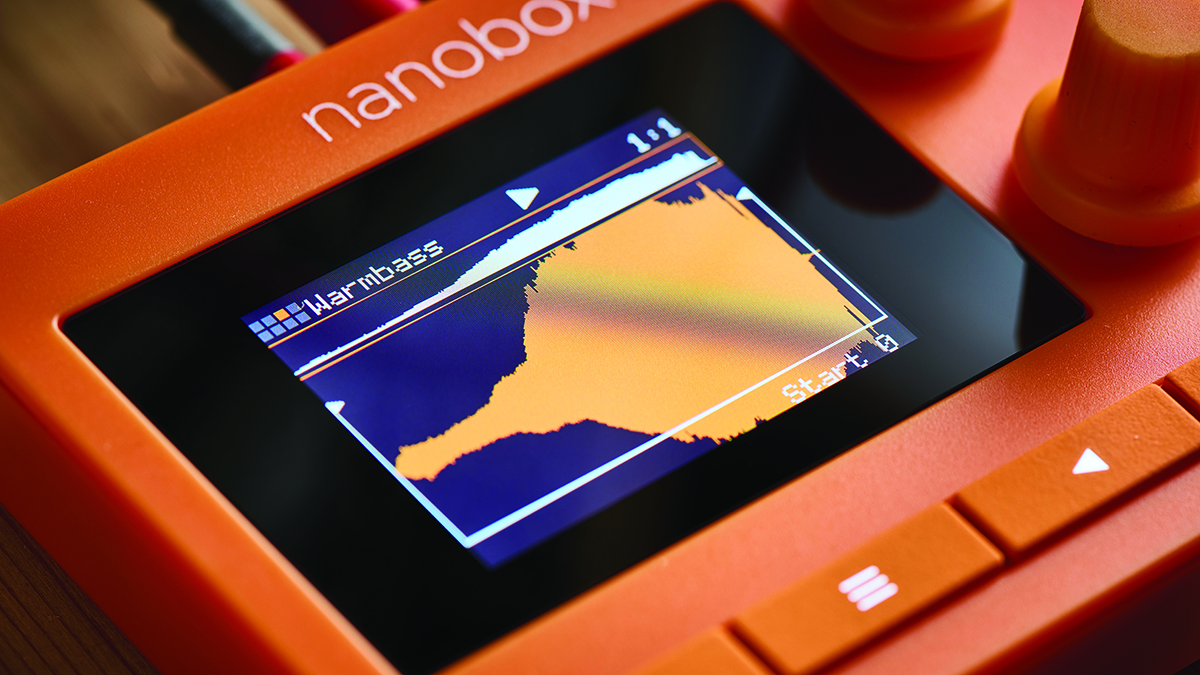MusicRadar Verdict
The Nanobox range gets a sampler and a powerful one at that. 1010music has done a great job squeezing so much into this tiny box.
Pros
- +
A multitude of sampling options.
- +
SP-x0x-inspired workflow.
- +
A ton of bundled sample content.
Cons
- -
No onboard power.
- -
Sequencer slightly lets the side down.
- -
Could do with more effects.
MusicRadar's got your back
1010music Nanobox Tangerine: What is it?
1010music has been knocking out the Nanobox range for a few years now, and while the diminutive noise-makers have been mostly well-received, we’ve still had our reservations over usability within a device of this size.
First to fly out of the blocks were the Fireball wavetable and Lemondrop granular synths, which managed to pack a lot of sonic power in such a small footprint. Then along came the Razzmatazz, all pretty in pink and chock full of lo-fi grimy FM beats. Now we have the fourth instalment in the Nanobox range, the Tangerine. Can this tiny sampler cut the mustard or will it fall foul of similar issues we’ve seen in the range so far?

1010music Nanobox Tangerine: Performance and verdict
A quick tour of the specs and the controls are very much the same as before with the two rotary dials, four buttons and touchscreen adorning the front panel. The I/O is also the standard Nanobox fayre with 3.5mm MIDI in/out (5-pin DIN adapter incl.), Clock out, stereo line in/out and a micro SD card slot loaded with over 500 samples (1500 wav files), with the unit’s power coming via the USB-C port (USB A to C cable incl.).

• Teenage Engineering EP-133 K.O.II
Retro vibes for days with TE’s newest sampler. Yes, it’s limited, but an onboard mic and plenty of effects add to the fun factor.
• Roland SP-404 mkII
A cult classic! The mkII makes tons of improvements without alienating the fanbase. It’s the ‘pros’ choice.
• Novation Circuit Rhythm
The best playable pad experience in the sub £/$500 sampler market and the Li-ion battery delivers up to four hours of play time.
The selection of samples on offer is varied from the utilitarian to the abstract. The preset list starts with multi-sampled pianos before working through beats and synths to foley and sound effects from Soundtrack Loops. Previous Nanobox users will be familiar with the layout with navigation on par with Razzmatazz. This also means the return of the Teleporter, a quick navigation page that allows you to quickly jump to each menu window. Holding down the Home key at any point will magically teleport you to a page with all the menus laid out. Honestly, without this, you can get lost navigating your way around all the menus and sub-menus.
Tangerine has up to 24 notes of polyphony if utilising the 64MB of onboard storage per sample pad, which is then divided for each subsequent sample pad used, or eight stereo files running from the micro SD card with a max sample size of 4GB. Each pad can operate in four different modes: Sample for one-shots, hits and multi-sample for mapping across the keyboard, Clip for creating quantised loops and Slicer for triggering different sections within a WAV file. Despite being called a ‘Streaming Sampler’, suggesting only sample playback is available, the final pad mode available is Record. You can sample directly via the stereo line-in port and create your own multi-samples, one-shots or loops. There’s an SP-x0x-like workflow here, which felt slightly tricky at first, but soon became pretty painless and ultimately fun. This is where Tangerine’s albeit small screen comes to the fore. It’s responsive and there’s no lag with the UI, which in itself is thoughtfully designed overall. However, for the full ‘sampling’ experience we feel you will need to plug in a MIDI key or pad controller to get the most out of it.

Pad power
Within each pad, samples can be processed within two menus, the Macro screen for processing pitch, panning, level and filtering, with further access to the LFO, envelope, and then the Position and Configure menus. Within Configure, you can select the sample Launch mode, whether it’s Trigger to play the sample in its entirety, Gate which plays until the pad is released, Tap to start the sample and then a second tap to stop it or Piano, a combination of Gate and Trigger modes to better emulate a piano’s behaviour. Here you can also set up Exclusion Group for preventing one or more pads from playing at the same time.

Limitations
The main limitation with Tangerine when compared to Razzmatazz is the lack of sequence editing. One of Razzmatazz’s plus points was the addition of the Super Stepper, which doesn’t make a comeback here, unfortunately. Although understandable given that Super Stepper is only capable of dealing with just one-shot samples, we would‘ve liked to have seen an evolution of the sequencer here. Generally, the sequencing on the whole is a bit of a letdown. A bigger screen, for instance, could be the answer for implementing something like a piano roll for sequencing melodic content, although, more realistically would be a tracker-like sequencer.
To further compound the issue, there isn’t even an option to undo a recording or an overdub at the moment, but possible in a future firmware update perhaps? For some, such limitations can be seen as a positive. The lack of sequence editing will force you to change your approach when hitting that record button. You can either hone your skills to capture the perfect take when building up a clip or embrace the happy accidents and wonky takes. That’s what sampling is about, right?

Another minor negative point is that Tangerine only features two effects, delay and reverb per pad with a global compressor. It’s got us feeling a little cheated when compared to the rest of the Nanoboxes, which are far richer in signal processing. Razzmatazz, for instance, comes with three effects slots, with the third one reserved for distortion and a cab sim and it feels like distortion is what’s missing from Tangerine. Presumably this limitation is giving way to far more hungry parameters and functionality, which is fine, but we’re wondering if one slot for spatial and the other for more sound-mangling effects would’ve been better?
So far, the entire Nanobox range is generally a force for good
So far, the entire Nanobox range is generally a force for good. 1010music has done a fine job of ramming a lot of sampler into a tight space. The main caveat, however, is true portability, or the lack thereof. No onboard battery seems to nullify the need for such a small device. Price-wise, Tangerine is up against stiff competition in the diminutive portable sampler stakes as well.
To create a feature-rich UI within the contraints of a screen this size is no mean feat, but we’d still like it to be a bit bigger.
MusicRadar verdict: The Nanobox range gets a sampler and a powerful one at that. 1010music has done a great job squeezing so much into this tiny box.
1010music Nanobox Tangerine: Hands-on demos
1010music
BoBeats
sonicstate
Battery Operated Orchestra
1010music Nanobox Tangerine: Specifications
- KEY FEATURES: Compact Streaming Sampler. Up to 24 voices of polyphony and 16 sequences per preset. 32 GB MicroSD card with 85 presets and over 1500 wav files. Colour matched USB-A to -C power cable and 5-pin MIDI to TRS cable included.
- I/O: 3.5mm MIDI in/out, Stereo line in/out, USB-C, Micro SD card slot.
- DIMENSIONS: 95 x 76 x 38mm.
- WEIGHT: 110g.
- CONTACT: 1010music

I take care of the reviews on MusicRadar and Future Music magazine, though can sometimes be spotted in front of a camera talking little sense in the presence of real musicians. For the past 30 years, I have been unable to decide on which instrument to master, so haven't bothered. Currently, a lover of all things high-gain in the guitar stakes and never one to resist churning out sub-standard funky breaks, the likes of which you'll never hear.
““We were arguing a lot and we were miserable”: How Green Day exceeded expectations with their most ambitious song
"There’s plenty for us guitarists to learn – and ‘less is more’ is the overriding lesson": how to play like George Harrison on The Beatles' Abbey Road
“They didn’t like Prince’s bikini underwear”: Prince’s support sets for the The Rolling Stones in 1981 are remembered as disastrous, but guitarist Dez Dickerson says that the the crowd reaction wasn’t as bad as people think














